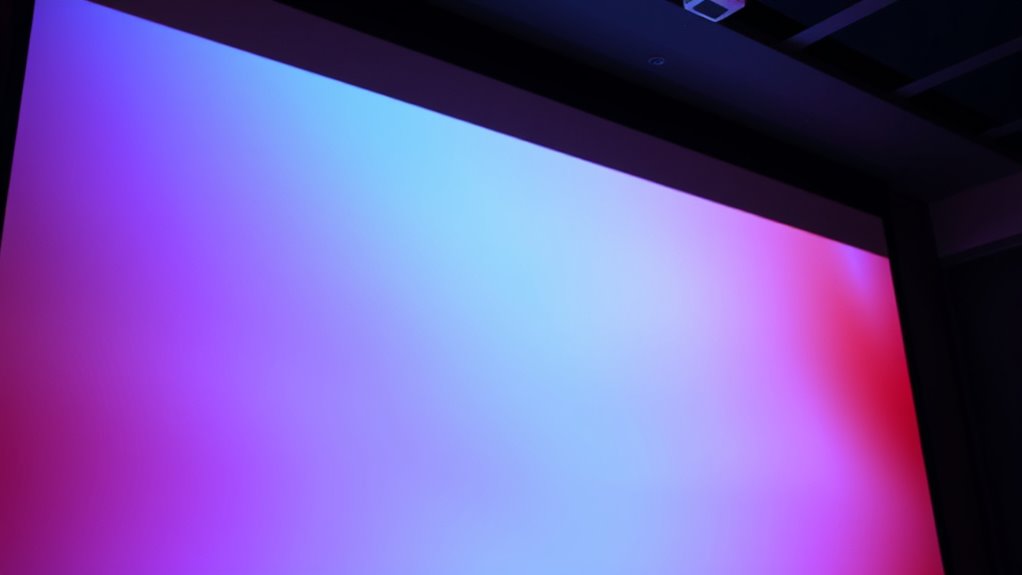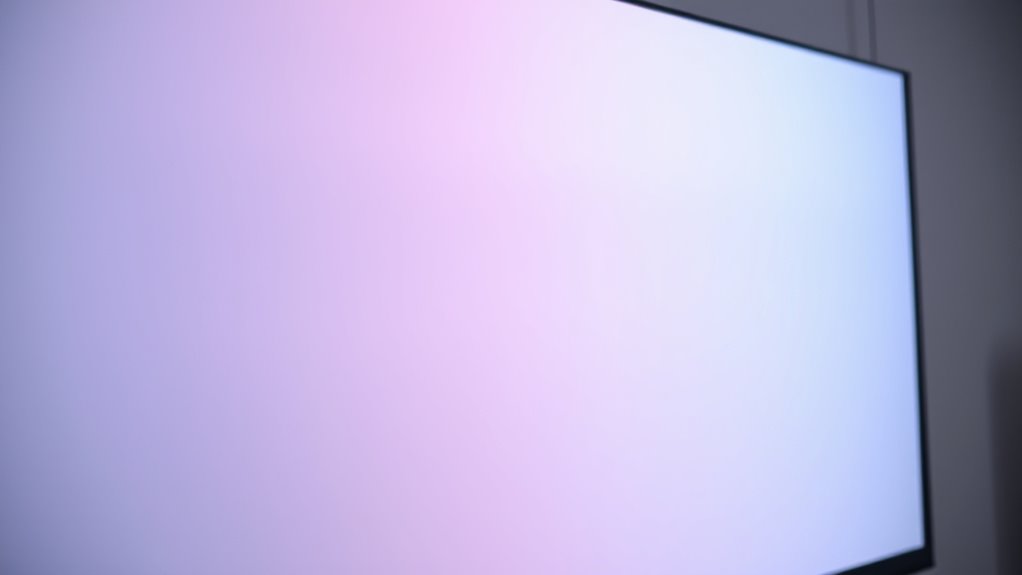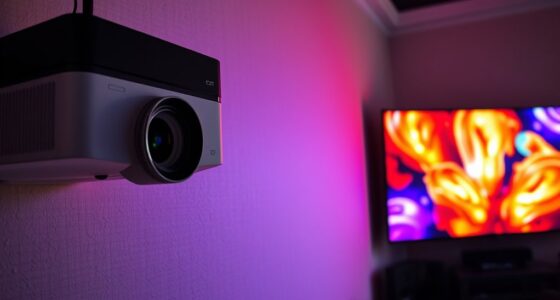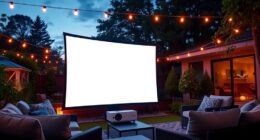If your projector’s colors look washed out, it’s often due to an aging or dimming bulb, improper color settings, or environmental factors like bright ambient light. You should check and calibrate the projector’s color settings, replace the bulb if it’s nearing the end of its lifespan, and make sure the lens is clean. Adjusting the room lighting can also make a big difference. Keep exploring to discover more ways to improve your projector’s color vibrancy.
Key Takeaways
- Color calibration may be off; accessing projector settings and restoring or adjusting color settings can improve vibrancy.
- An aging or dimming bulb reduces brightness and dulls colors; replacing the bulb can restore vivid images.
- Dirty lenses or dust buildup can diffuse light, dulling colors; cleaning the lens enhances color clarity.
- External ambient light can wash out colors; reducing room lighting improves image brightness and color perception.
- Internal technology differences (DLP vs. LCD) impact color accuracy; selecting proper preset modes optimizes color reproduction.

If your projector’s colors look washed out, it can be frustrating, but the issue is often easier to fix than you might think. One of the first things to check is your projector’s color calibration. Over time, the settings can shift, causing colors to lose vibrancy. Access your projector’s menu and look for the color calibration or color settings option. Adjusting these settings can restore the richness and accuracy of colors, making your images pop again. Be careful not to overdo it; small tweaks often yield the best results. Also, consider resetting the color settings to their default if you’re unsure of what adjustments to make. Proper color calibration ensures that the colors are true to life, which is essential for a vivid viewing experience. Additionally, color accuracy can be affected by the projector’s internal technology, such as DLP vs. LCD, which influences how well colors are reproduced. Another common culprit behind washed-out colors is bulb brightness. Projector bulbs gradually dim as they age, losing their ability to produce bright, vibrant images. If your projector has been in use for several thousand hours, the bulb might be nearing the end of its lifespan. In such cases, replacing the bulb can considerably improve color intensity and overall picture quality. Before replacing the bulb, check the projector’s lamp hours, which are usually displayed in the settings menu. If the lamp is nearing its rated lifespan, replacing it should be your next step. Keep in mind that a dimmer bulb results in less light reaching the screen, which can make colors appear dull and washed out. Upgrading to a new bulb will often restore the brightness and color vibrancy you expect. In addition to calibration and bulb brightness, make sure your projector is set to the correct picture mode. Many projectors have preset modes like cinema, dynamic, or standard, which adjust color and brightness levels. Switching to a mode designed for high-quality image reproduction, such as cinema or vivid mode, can enhance colors. Also, ensure the projector’s lens is clean and free of dust or smudges, as dirt can diffuse light and dull colors. Adjust the ambient lighting in your viewing area as well—bright surroundings can wash out projected images. Combining proper calibration, fresh bulbs, and ideal settings will usually resolve washed-out colors and deliver a sharper, more vibrant picture.
Frequently Asked Questions
Can Ambient Lighting Affect Projector Color Quality?
Yes, ambient light can affect your projector’s color quality. Too much ambient light reduces contrast and washes out colors, making them appear dull or faded. It also impacts your color perception, causing you to see colors less vividly. To improve this, dim the ambient light in your viewing area or use blackout curtains. This helps your projector deliver truer, more vibrant colors and enhances your overall viewing experience.
How Does Projector Bulb Age Impact Color Vibrancy?
As your projector bulb ages, its bulb lifespan shortens, leading to color degradation. You’ll notice colors becoming less vibrant and more washed out over time. This happens because the bulb’s brightness diminishes, reducing color accuracy and intensity. To maintain vivid colors, replace the bulb before it reaches the end of its lifespan. Regularly monitoring your bulb’s condition helps prevent the decline in color vibrancy and guarantees ideal image quality.
Are There Specific Settings to Enhance Color Saturation?
Think of your projector like a painter’s palette—vibrant colors make the image pop. You can enhance color saturation by adjusting picture settings and performing color calibration. Increase contrast, tweak color temperature, and boost saturation levels for richer visuals. Experiment with these settings until you find the perfect balance, ensuring your projector displays vivid, true-to-life colors. This simple calibration makes your viewing experience much more immersive and visually appealing.
Does Screen Type Influence Color Accuracy?
Yes, your screen type influences color accuracy. Different screens, like LCD or DLP, display colors differently due to variations in screen resolution and color calibration. A higher resolution usually provides sharper images, but proper color calibration guarantees more vibrant, true-to-life colors. Adjust your projector’s settings to match your screen type, and make sure it’s calibrated correctly to avoid washed-out colors. This way, your display will look more vivid and accurate.
Can Using Different Cables Improve Color Performance?
Using different cables can definitely improve color performance. Think of your cables as the pipeline for color information; if they’re of poor quality, it’s like trying to pour water through a clogged pipe—connection stability suffers, and colors appear washed out. Opt for high-quality HDMI or DisplayPort cables to guarantee a clear, stable connection. Better cable quality means less signal loss, so your projector displays vibrant, true-to-life colors more accurately.
Conclusion
So, next time your projector’s colors look more like a faded memory than a vibrant display, remember it’s probably not a cosmic conspiracy. Maybe it’s just a simple fix, or maybe your device is secretly auditioning for a role in a monochrome film. Either way, don’t let washed-out images dampen your movie night — after all, a little troubleshooting now can save you from perpetual grayscale despair later. Embrace the shades of gray; it’s the new black.









